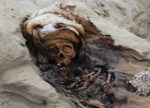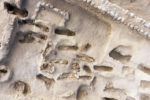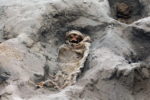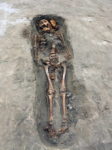 Archaeologists have discovered the remains of another six sacrificed children in the ancient city of Huanchaco on the northern coast of Peru. They had cut marks on the thorax from when their hearts were moved, and were placed in graves facing the ocean. Some of the skeletons still have remnants of skin and hair.
Archaeologists have discovered the remains of another six sacrificed children in the ancient city of Huanchaco on the northern coast of Peru. They had cut marks on the thorax from when their hearts were moved, and were placed in graves facing the ocean. Some of the skeletons still have remnants of skin and hair.
 The graves were unearthed in the town’s Pampa la Cruz neighborhood where 56 skeletons were found in June of last year, but unlike previous finds, these children were interred with precious artifacts, gold and silver jewelry and feather and textile headdresses. These are markers of rank, an indication that the children came from wealthy noble and/or priestly families.
The graves were unearthed in the town’s Pampa la Cruz neighborhood where 56 skeletons were found in June of last year, but unlike previous finds, these children were interred with precious artifacts, gold and silver jewelry and feather and textile headdresses. These are markers of rank, an indication that the children came from wealthy noble and/or priestly families.
“This is the biggest site where the remains of sacrificed children have been found,” chief archeologist Feren Castillo told AFP on Tuesday.
Castillo said the children, who were aged between four and 14, were sacrificed in a ritual to honor the Chimu culture’s gods.
“They were sacrificed to appease the El Nino phenomenon,” and show signs of being killed during wet weather, he said.
He added that there may still be more to be found.
“It’s uncontrollable, this thing with the children. Wherever you dig, there’s another one,” Castillo said.
 Today Huanchaco is a popular beach destination outside the colonial city of Trujillo. It has been inhabited by a chronology of Peruvian cultures since the Salinar first fished there between 400 and 200 B.C. The Chimú culture ruled the area from the mid-9th century until they were conquered by the Inca in 1470. At the time of the mass sacrifices — 1200 to 1400 A.D. — Huanchaco was the main port of the Chimú capital Chan Chan.
Today Huanchaco is a popular beach destination outside the colonial city of Trujillo. It has been inhabited by a chronology of Peruvian cultures since the Salinar first fished there between 400 and 200 B.C. The Chimú culture ruled the area from the mid-9th century until they were conquered by the Inca in 1470. At the time of the mass sacrifices — 1200 to 1400 A.D. — Huanchaco was the main port of the Chimú capital Chan Chan.
 The latest finds bring the total tally of sacrificed children discovered at the site up to 227. The skeletal remains of more than 50 adult men, likely warriors, have also been found, but they range in date from the 8th century through the 15th, so were not part of the single large sacrifice event that claimed the lives of the children and more than 200 camelids, believed to be llamas.
The latest finds bring the total tally of sacrificed children discovered at the site up to 227. The skeletal remains of more than 50 adult men, likely warriors, have also been found, but they range in date from the 8th century through the 15th, so were not part of the single large sacrifice event that claimed the lives of the children and more than 200 camelids, believed to be llamas.